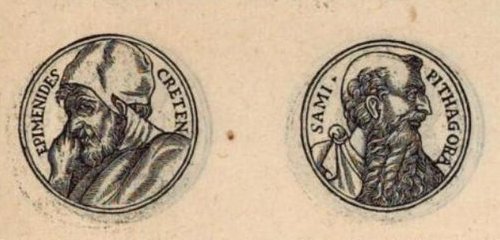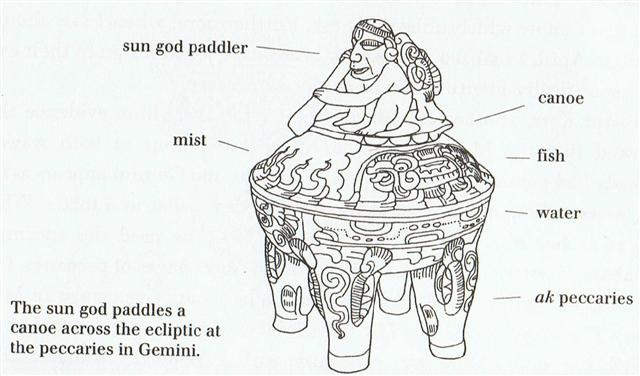The Creation of our present world took place in August 13 (225) at the time when the Full Moon would have been at day 225 + 183 - 365 = 408 (= 365 + 43 = February 12). We should remember that on the G tablet Sirrah was at glyph number 408, which in a way confirms that 0h was connected with day 225. ... Remarkably 225 - the distance between heliacal date and culmination date - stood still in January-February:
Castor (193) - Arneb (163) = 30 = Castor (419) - Arneb (389).
From day 168 (June 17 at heliacal Begelgeuze) to August 13 (Creation of our present world) there were 225 - 168 = 57 days. ... The original story was by Diogenes Laertius, an Epicurean philosopher circa early half third century, in his book On the Lives, Opinions, and Sayings of Famous Philosophers. The story is in Chapter ten in his section on the Seven Sages, who were the precursors to the first philosophers. The sage was Epimenides. Apparently Epimenides went to sleep in a cave for fifty-seven years. But unfortunately, 'he became old in as many days as he had slept years'. Although according to the different sources that Diogenes relates, Epimenides lived to be one hundred and fifty-seven years, two hundred and ninety-nine years, or one hundred and fifty-four years. A similar story is told of the Seven Sleepers of Ephesus, Christian saints who fall asleep in a cave while avoiding Roman persecution, and awake more than a century later to find that Christianity has become the religion of the Empire ...  Or counting from the return to visibility: 225 (August 13) - 184 (July 3) = 41 days as in the star of birth, 41 Arietis (Bharani), located at *41.4.
From August 13 (225) to June 17 (168) there were 365 + 168 - 225 = 308 (= 408 - 100 = 88 + 220) days. Should we count 308 glyphs backwards from the last glyph on side b of the B tablet (corresponding to June 17 at heliacal Betelgeuze) we should therefore arrive at August 13, and 506 (Bb12-45, heliacal Betelgeue) - 308 = 198 = Bb5-35 (→ 53 * 5 = 265 = 225 + 40 = 185 + 80 = 161 + 104):
On the other hand, another approach could be to go forward from August 13 (225) to where the 'navel string of the earth' (te pito o te fenua) was cut off (kua motu) at Bb6-13 (216): ... The little spring was concealed by a succulent growth of strange plants, bearing gigantic leaves and pendant clusters of long yellow fruit, which she named bananas. The intervening space was filled with a luxuriant growth of slender stems and twining vines, of which she called the former sugar-cane and the latter yams; while all around the house were growing little shrubs and esculent roots, to each one of which she gave an appropriate name. Then summoning her little boy, she bade him gather the breadfruit and bananas, and, reserving the largest and best for the gods, roasted the remainder in the hot coals, telling him that in the future this should be his food. With the first mouthful, health returned to the body of the child, and from that time he grew in strength and stature until he attained to the fullness of perfect manhood. He became a mighty warrior in those days, and was known throughout all the island, so that when he died, his name, Mokuola [Motu-ora], was given to the islet in the bay of Hilo [Hiro] where his bones were buried; by which name it is called even to the present time ...
Because a key glyph is Bb6-13 (→ 61 * 3 = 183), where Metoro stated: kua motu te pito o te fenua. His use of Tahitian fenua instead of henua was surely intended to be noticed. Henua. Land, ground, country; te tagata noho i ruga i te henua the people living on the earth. Placenta: henua o te poki. Vanaga. Motu. 1. To cut; to snap off: motu-á te hau, the fishing line snapped off; to engrave, to inscribe letters or pictures in stone or in wood, like the motu mo rogorogo, inscriptions for recitation in lines called kohau. 2. Islet; some names of islets: Motu Motiro Hiva, Sala y Gómez; and around the island: Motu Nui, Motu Iti, Motu Kaokao, Motu Tapu, Motu Marotiri, Motu Kau, Motu Tavake, Motu Tautara, Motu Ko Hepa Ko Maihori, Motu Hava. Motu rau uri, southeast wind. Motu takarua, west wind. Vanaga. To break, to cut with a knife, to sever, to rupture; rent, reef, shoal, rock; motu poto, to cut short; aretare motu, an oratory; motu kivakiva, an uncovered shoal; motumotu, to cut up; tae motumotu, e ko motumotu, indissoluble. P Pau.: motu, island; komutu, to break. Mgv.: motu, an island, a rock, to cut, to be broken. Mq.: motu, island, land, to break, to cut up, to take to pieces. Ta.: motu, a low island, to be broken, cut up. Motuava (motu - ava 1), a hollowed rock. Motuhaua, archipelago. Motupiri (motu - piri), archipelago. Motuputuputu (motu - putuputu), archipelago. Moturauri, south wind T. Moturogorogo, to write T. Churchill. H Moku 1. To be cut, severed, amputated, broken in two, as a rope; broken loose, as a stream after heavy rains, or as a bound person; to punctuate. Moku ka pawa, dawn has broken. Kai moku ka noho 'ana, relations separated by the sea. Ho'o moku, to cut and divide; a cutting, division, separation. 2. District, island, islet, section, forest, grove, clump, severed portion, fragment, cut, laceration, scene in a play. Cfr. mokupuni, momoku. Moku lehua, lehua forest. Ho'o moku, to place one over a moku, district. 3. Ship, schooner, vessel, boat, said to be so called because the first European ships suggested islands. 4. A stage of pounded poi (such poi sticks together as a mass and can be separated cleanly - moku - from the pounding board). Wehewehe. Pito. 1. Umbilical cord; navel; centre of something: te pito o te henua, centre of the world. Ana poreko te poki, ina ekó rivariva mo uru ki roto ki te hare o here'u i te poki; e-nanagi te pito o te poki, ai ka-rivariva mo uru ki roto ki te hare, when a child is born one must not enter the house immediately, for fear of injuring the child (that is, by breaking the taboo on a house where birth takes place); only after the umbilical cord has been severed can one enter the house. 2. Also something used for doing one's buttons up (buttonhole?). Vanaga. Navel. Churchill. H Piko 1. Navel, navel string, umbilical cord. Fig. blood relative, genitals. Cfr piko pau 'iole, wai'olu. Mō ka piko, moku ka piko, wehe i ka piko, the navel cord is cut [friendship between related persons is broken; a relative is cast out of a family]. Pehea kō piko? How is your navel [a facetious greeting avoided by some because of the double meaning]? 2. Summit or top of a hill or mountain; crest; crown of the head; crown of the hat made on a frame (pāpale pahu); tip of the ear; end of a rope; border of a land; center, as of a fishpond wall or kōnane board; place where a stem is attached to the leaf, as of taro. 3. Short for alopiko. I ka piko nō 'oe, lihaliha (song), at the belly portion itself, so very choice and fat. 4. A common taro with many varieties, all with the leaf blade indented at the base up to the piko, junction of blade and stem. 5. Design in plaiting the hat called pāpale 'ie. 6. Bottom round of a carrying net, kōkō. 7. Small wauke rootlets from an old plant. 8. Thatch above a door. 'Oki i ka piko, to cut this thatch; fig. to dedicate a house. Wehewehe.
Sirrah was (at) the Navel of the Horse and half a year away another navel (pito) could be expected. At 0h the Sun crossed over from one hemisphere to the other and later at 12h he would return in order to cross over in the opposite direction. ... Then three lines are drawn east and west, one across the northern section indicates the northern limit of the Sun (corresponding with the Tropic of Cancer) about the 15th and 16th days of the month Kaulua (i.e., the 21st or 22nd of June) and is called ke alanui polohiwa a Kane, the black-shining road of Kane. The line across the southern section indicates the southern limit of the Sun about the 15th or 16th days of the month Hilinama (December 22) and is called ke alanui polohiwa a Kanaloa, the black-shining road of Kanaloa. The line exactly around the middle of the sphere is called ke alanui a ke ku'uku'u, the road of the spider, and also ke alanui i ka Piko a Wakea, the way to the navel of Wakea (the Sky-father). Between these lines are the fixed stars of the various lands, na hokupaa a ka aina. (These are the stars which hang suspended in the zeniths of the Polynesian islands most of which lie within the tropics.) On the sides are the stars by which one navigates ...
|
|||||||||||||||||||||||||||||||||||||||||||||||||||||||||||||||||||||||||||||||||||||||||||||||||||||||||||||||||||||||||||||||||||||||||||||||||||||||||||||||||||||||||||||||||||||||||||||||||||||||||||||||||||||||||||||||||||||||||||||||||||||||||||||||||||||||||||||||||||||||||

















